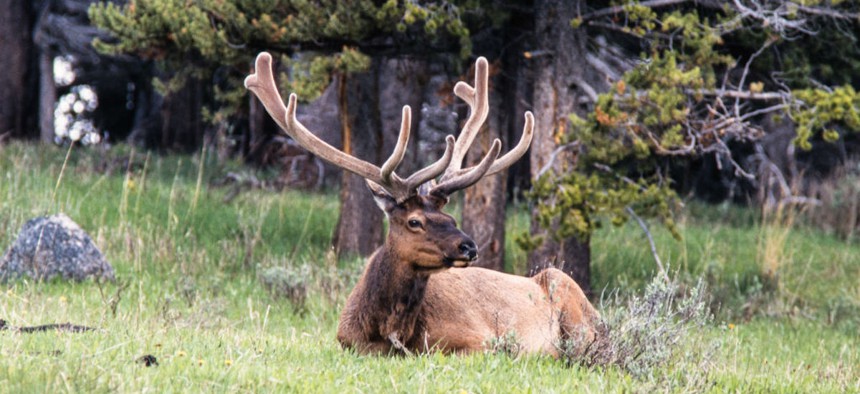Herding elk: Drone use takes off in wildlife management

A bull elk resting in Yellowstone National Park in Wyoming. Jon G. Fuller / VWPics/Universal Images Group via Getty Images
Wardens and biologists are finding ever-expanding uses for unmanned aircraft, which are being deployed across Wyoming and other states, saving on time and resources.
This story is republished from WyoFile. Read the original article.
From its mobile perch high in the sky, the infrared camera didn’t detect so much as a jackrabbit.
Jared Rogerson, a Wyoming Game and Fish Department wildlife disease biologist, wielded the controller of the DGI Matrice 300 drone from a flat, grassy field just outside of the Bench Corral Elk Feedground’s fenced haystacks. He scanned one acre of sagebrush and grass after the next. This was the state agency’s top-of-the-line drone, a roughly $12,000 machine, and he was familiar with its impressive critter-finding capabilities. Any body heat on the screen shows up white, and it doesn’t take a bull moose to register.
“I was flying around the willows one day, and I saw a white dot,” Rogerson recalled. “I thought maybe it was the ear of an elk.”
He zoomed in. A certain spiny rodent appeared.
“It was a porcupine,” Rogerson chuckled.
On this Tuesday morning, there were no porcupines detected while hovering above the Green River Basin’s sagebrush sea. No elk, either, although it was a week into February, a time of year when wapiti would typically be gathered over hay at the state’s feedgrounds—like this one.
“This is not normal, but it’s not uncommon either,” Rogerson said about not feeding elk. “We have a mild year every six or seven years. The elk are behaving, they’re staying out of trouble and they’ve got plenty of forage.”
The unfed elk are also harder and more expensive to count, because they’re dispersed on the landscape instead of lined out over hay. The going rate for helicopter time is close to $900 an hour, according to John Lund, the agency’s Pinedale Region supervisor.
But the state’s drones could make the elk-tallying task cheaper and more efficient in no-feeding winters like this one, which could become more frequent down the road. Artificial intelligence models to help count elk and other ungulates is another emerging tool.
“It’s pretty quick to get the footage, and it’s a long time in front of a computer to sit there and count all the elk,” Rogerson said. “We can actually feed the video footage into the [AI] model, and it will calculate the total number of elk in the video.”
Rogerson and Lund, both Federal Aviation Administration-certified drone pilots, are not yet to the point where using AI to read drone video is an ironclad part of the process of assessing the Piney Elk Herd and other ungulate herds in the region. And there are no imminent plans to move away from long-standing techniques like counting elk on the feedlines and flying biologists in helicopters. Still, it’s clear that drones are making some wildlife management tasks easier, safer and more efficient—and the sky’s the limit, as far as the new technology’s potential in wildlife management.
Herding from the Sky
During the severe, deadly winter of 2022-’23, Rogerson and Lund used drones to help with the often painstaking process of herding elk away from conflict situations on cattle pastureland.
In places like the Green and Hoback River basins, elk herds can get stranded on private land in big snow years. They survive by eating hay intended for cattle at night, and take shelter in the timber or willows along river-bottoms during the days. Pushing them off of a property—or even killing them to end the problem—can be exceedingly difficult.
“In the past that would involve several guys on snowmachines fishing their way through the willow bottoms, which isn’t easy,” Lund said. “You can’t see. We spend a lot of time stuck. And we’re running elk around in circles all day long.”
Drones spent over 11 hours in the air on 10 different occasions during the winter of 2022-’23 assisting with moving elk, according to Game and Fish’s “job completion report” for the Pinedale Region.
“Furthermore, in order to prevent elk-cattle commingling, 18 elk were culled from two different locations with the aid of the aerial drone,” the report said, “which effectively located and dispersed the animals to locations where they could be targeted.”
Lund recounted how drones simplified the process: “You could sit right at the truck, and go find the elk,” he said. “Then flush them out of the willows to where you can pick them up on a snowmachine.”
With a drone, Rogerson said, nuisance elk can essentially be herded: “It’s the only thing I’ve found where you can control the direction that you want them to go.”
Even a smaller model of drone descending down toward the wapiti seems to make them spook, he said. Then, if they go the wrong direction, the machine’s maneuverability can quickly redirect them, not unlike a herding dog.
“If they start to go one way,” Rogerson said, “you can get around them and bump them in the direction you want them to go.”
Ty Smucker, a member of The Wildlife Society’s drone working group, wasn’t surprised by Wyoming Game and Fish biologists’ successes herding elk with a drone.
“Bighorn sheep don’t seem to care about drones, nor do moose. And mule deer don’t really care, either,” said Smucker, who’s on staff as a Helena-based biologist for the Montana Department of Fish, Wildlife and Parks. “But whitetail deer and elk really don’t like drones.”
Many Applications
Smucker’s of the mind that drones are useful devices that deserve a spot in any biologist’s toolbox alongside binoculars, GPS units and telemetry receivers. He first got interested in using drones to help with routine wildlife management about two decades ago, partly out of concern for his own safety.
“I’ve had three colleagues killed in aircraft crashes,” Smucker said. “That’s the number one most common way that biologists die.”
“I’ve had three colleagues killed in aircraft crashes. That’s the number one most common way that biologists die.”
- TY Smucker, a member of The Wildlife Society's drone working group
In Montana, wildlife managers brought drones into the mix back in 2015. Uses are regularly expanding, but the remote-controlled aircraft have been deployed to count wolf pups at den sites, monitor bighorn sheep herds being hit hard by pneumonia and locate grizzly bears in corn fields or in residential areas.
“They’re using them to haze bears, too—that’s pretty new,” Smucker said. “In Montana we’re also using them to chase bears and herds of elk and deer out of people’s crops. We did that for the first time last summer, and it works pretty well.”
The Wyoming Game and Fish Department brought drones into the mix a few years later than Montana, debuting the aerial tool around 2019, according to Lund. Field-level staff around the state formed a loose-knit committee to share their experiences with how they were using the first four or five drones the agency purchased.
Getting the hang of operating the drone came pretty easy for Rogerson. They’re pretty user friendly, he said, noting there was a steeper learning curve for understanding how the animals responded to the aircraft.
The tool quickly earned its keep with Wyoming wildlife managers, Lund said. In central and eastern Wyoming, biologists have used them to help evaluate crop damage, he said. In the Pinedale Region, they’ve also used drones to help determine when to end the elk-feeding season, Rogerson said
“We have some software where I can plug a [drone] photo in,” he said, “and it will actually spit out the percentage of snow cover.”
Drones have been used to assess wetland rehabilitation on state lands near Pinedale, and there have been plenty of other random occasions when they’ve come in handy. Lund thought back to a couple of years ago when there was an ice fishing derby on Fremont Lake before ice cover was 100%. They flew a drone to get photos to show participants the safety hazard.
There are still obstacles preventing drones from being a workhorse tool that overhauls how Wyoming biologists and wardens do their daily jobs. Battery life is limited—Rogerson’s DGI could go a little more than a half-hour before he steered it back to a landing pad. And there are FAA regulations, like a 400-foot flight ceiling and requiring a user to maintain line-of-sight on the aircraft with the naked eye.
“We’re just dipping our toes in the water, so to speak,” Game and Fish Chief Warden Rick King said. “I think in the future there’s going to be tons of applications for them.”
“We spend a lot of money on aerial flights,” he added. “Eventually, I’m confident drones are going to allow us to reduce that expense and risk.”
WyoFile is an independent nonprofit news organization focused on Wyoming people, places and policy.





